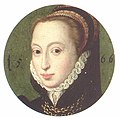File:Jean Gordon, Countess of Bothwell (3772866141).jpg

Original file (656 × 644 pixels, file size: 174 KB, MIME type: image/jpeg)
Captions
Captions
Summary edit
| Artist |
Unidentified miniature painter
|
||||||||||||||||||||||||||
| Description |
Lady Jean Gordon, Countess of Bothwell, 1544 - 1629. First wife of James Hepburn, 4th Earl of Bothwell
|
||||||||||||||||||||||||||
| Date |
1566 date QS:P571,+1566-00-00T00:00:00Z/9 |
||||||||||||||||||||||||||
| Medium |
oil on copper medium QS:P186,Q296955;P186,Q753,P518,Q861259 |
||||||||||||||||||||||||||
| Dimensions |
diameter: 3.5 cm (1.3 in) dimensions QS:P2386,3.5U174728 |
||||||||||||||||||||||||||
| Collection |
institution QS:P195,Q2441562 |
||||||||||||||||||||||||||
| Current location |
Print Room |
||||||||||||||||||||||||||
| Accession number |
PG 870 |
||||||||||||||||||||||||||
| Credit line | Purchased 1917 | ||||||||||||||||||||||||||
| References | https://www.nationalgalleries.org/art-and-artists/1869/lady-jean-gordon-countess-bothwell-1544-1629-first-wife-james-hepburn-4th-earl-bothwell | ||||||||||||||||||||||||||
| Source/Photographer | Lisby from Western Maryland, United States (Jean Gordon, Countess of Bothwell, uploaded by Magnus Manske) | ||||||||||||||||||||||||||
| Other versions |
Counterpart (pendant of):: |
||||||||||||||||||||||||||
Licensing edit
- You are free:
- to share – to copy, distribute and transmit the work
- to remix – to adapt the work
- Under the following conditions:
- attribution – You must give appropriate credit, provide a link to the license, and indicate if changes were made. You may do so in any reasonable manner, but not in any way that suggests the licensor endorses you or your use.
| This image, originally posted to Flickr, was reviewed on 14 September 2012 by the administrator or reviewer File Upload Bot (Magnus Manske), who confirmed that it was available on Flickr under the stated license on that date. |
File history
Click on a date/time to view the file as it appeared at that time.
| Date/Time | Thumbnail | Dimensions | User | Comment | |
|---|---|---|---|---|---|
| current | 10:14, 14 September 2012 |  | 656 × 644 (174 KB) | File Upload Bot (Magnus Manske) (talk | contribs) | Transferred from Flickr by User:Magnus Manske using flickr2commons |
You cannot overwrite this file.
File usage on Commons
The following page uses this file:

